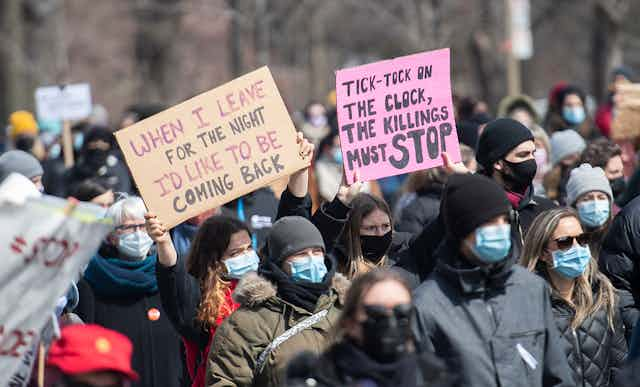In 2022, 184 women and girls were killed by violence in Canada. This number has steadily increased in each of the past three years; 148 women and girls were killed in 2019, 172 in 2020 and 177 in 2021.
There were 6,423 incidences of anti-2SLGBTQIA+ protests and online hate in Canada in the first three months of 2023 alone. Expressions of hate toward trans and non-binary people and 2SLGBTQIA+ people more broadly have been rising.
Transphobia and femicide are both forms of gender-based violence, defined as any form of violence directed toward somebody because of their gender, gender identity, gender expression or perceived gender.
My team of researchers, The Gender-Based Violence Teaching Network, created resources, professional development and a teaching toolkit to support more teachers to effectively teach students about the root causes and consequences of different forms of gender-based violence.

Devastating effects
Gender-based violence has devastating effects for those who experience it. In addition to immediate physical, psychological and/or sexual harm, it leads to increased economic insecurity and has detrimental impacts on mental health.
Gender-based violence is prevalent in our society. A 2021 survey by the Canadian Women’s Foundation showed that two-thirds of 1,515 Canadian respondents know a woman who has experienced physical, sexual or emotional abuse. Despite this high prevalence, it is often not examined in schools as a social issue.
My analysis of Ontario secondary school curricula showed that some form of gender-based violence is mentioned at all grade levels. It is most frequently mentioned in upper-level optional social sciences and humanities courses (such as Grade 11 Gender Studies or Grade 12 Challenge and Change in Society).
These elective courses are also more likely to help students examine how gender-based violence is influenced by systems of power, discrimination and social constructs, including through the intersections of gender and racialization, disability and socioeconomic status.

Need to learn how violence is normalized
Teachers told me that, unfortunately, these elective courses are not always offered and, when they are, they are most often taken by students already familiar with these ideas.
This means most Ontario students never learn about the connection between acts of violence and broader structures that normalize gender-based violence by discriminating against girls, women and 2SLGBTQIA+ people.
For example, Indigenous women and girls are 12 times more likely to be murdered or missing than other women in Canada. This disproportionate violence results from centuries of colonization, which continues to manifest through multigenerational and intergenerational trauma, social and economic marginalization, and institutional practices and social behaviours that maintain the status quo and ignore the agency and expertise of Indigenous women, girls and 2SLGBTQIA+ people.
Read more: Missing and murdered Indigenous women and girls: An epidemic on both sides of the Medicine Line

Overlooking power discrepancies
There are required courses that mention some forms of gender-based violence, most notably Grade 9 Health and Physical Education. However, my analysis of this curriculum found it frames gender-based violence as an issue of individual responsibility, overlooking the ways power discrepancies can influence the situation and impact a person’s ability to provide consent or respond to violence.
There are also brief mentions of several gender-based violence issues in the Grade 10 Canadian History and Civics and Citizenship courses, including missing and murdered Indigenous women and girls. My examination of the curriculum and teachers’ experience teaching it, however, demonstrates these curricula do not prompt critical analysis of the social causes that led to these acts of violence.

What effective teaching looks like
My research demonstrated that some teachers are teaching about gender-based violence issues. They explain that effective teaching about gender-based violence involves grappling with the power and privilege of both students and teachers, intentionally cultivating relationships with and between students and with community resources and considering the root causes of gender-based violence as connected to patriarchy, colonialism, heteronormativity and cisnormativity.
Students call for education that conveys the holistic consequences for victims as real people, not just statistics, and that empowers them to understand and prevent gender-based violence in their lives and communities.

Teaching toolkit
My team created resources and professional development to respond to teachers’ concerns that they lacked sufficient training and materials about gender-based violence, and that this discourages teaching about it.
Our Teaching About Gender-Based Violence Toolkit is available on our project website. The toolkit has lesson plans, guidance notes and other teaching materials to support teachers to address gender-based violence topics. It aligns to Grade 8-12 Ontario curriculum expectations.
Topics addressed include sexual assault, consent and healthy relationships, human trafficking, transphobia and homophobia, gender policing, cisnormativity and heteronormativity, missing and murdered Indigenous women, girls and Two-Spirit people and intimate partner violence.
More directly addressing gender-based violence through education can help the upcoming generation of Canadians understand how gender-based violence manifests across our society.

More education needed
The ongoing disappearance and murder of Indigenous women, girls and Two-Spirit people, the proliferation of hate toward 2SLGBTQIA+ people, the unmanageable demand for women’s shelters and the emergence of new forms of sexual violence facilitated by technology show the importance of more education about gender-based violence.
Broader awareness of its root causes and devastating consequences is necessary to better address it.
Teachers are uniquely placed to support the development of students’ understanding of gender-based violence. All educators are encouraged to explore the resources that we have created to help students understand that, tragically, gender-based violence exists all around them.
We need to teach students what it looks like and why it happens before we can empower them to collectively act to circumvent it in their lives and communities.

